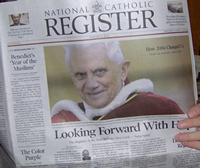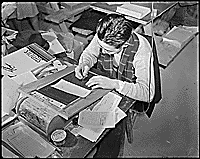Spotlight Archive
The National Catholic Register celebrates 80 years in publication this year. It is only one of many distinguished and storied newspapers published for American Catholics over the last two hundred years.
Claims to the designation “first” are especially difficult to adjudicate in the publishing world, where titles are changed frequently, ownership often changes hands, and defunct publications are occasionally reborn. Then there is the question of what constitutes a “newspaper.”
 Father Gabriel Richard’s Impartial Observer (Michigan, 1809) was almost certainly the first periodical published under Catholic auspices.The United States Catholic Miscellany, however, lays reasonable claim to be the first Catholic newspaper printed in the United States. Ironically, it appeared in one of the least Catholic regions of the country, the South. But Bishop John England was determined to present Catholicism as culturally and intellectually respectable amidst the non-Catholic social circles of Charleston, South Carolina, and the Miscellany was an important piece of his strategy. It was first published on June 22, 1822, went out of print due to war in 1861, and was rehabilitated by the Diocese of Charleston in the twentieth century.
Father Gabriel Richard’s Impartial Observer (Michigan, 1809) was almost certainly the first periodical published under Catholic auspices.The United States Catholic Miscellany, however, lays reasonable claim to be the first Catholic newspaper printed in the United States. Ironically, it appeared in one of the least Catholic regions of the country, the South. But Bishop John England was determined to present Catholicism as culturally and intellectually respectable amidst the non-Catholic social circles of Charleston, South Carolina, and the Miscellany was an important piece of his strategy. It was first published on June 22, 1822, went out of print due to war in 1861, and was rehabilitated by the Diocese of Charleston in the twentieth century.
New York boasted the Catholic Truth Teller from 1822–1855, and James McMaster published the Freeman's Journal and Catholic Register during the middle and late nineteenth century in the same city.
The oldest continuously published Catholic newspaper is probably the Boston Pilot. It was founded in September 1829 as The Jesuit or Catholic Sentinel by Bishop Benedict Fenwick. That title was deliberately provocative in early nineteenth-century New England, but Fenwick deemed a vigorous defense of Catholic ideas to be necessary for the increasing number of immigrant Catholics trickling ashore in Massachusetts. In 1838, Fenwick turned the paper over to lay publishers, including Patrick Donahue, who renamed the periodical the Pilot and guided it successfully for the next five decades. Naturally enough given its place of publication and the flood of emigres from the potato famine of the 1840s, the Pilot became identified with Irish-American Catholicism and gained a national reputation as a significant voice for Catholic opinion.
Only slightly later than the Pilot was the Cincinnati diocese’s Catholic Telegraph, first published October 22, 1831 and still in existence. Cincinnati was also home to what was likely the first German-language Catholic paper in the United States, Der Wahrheitsfreund, founded by John Martin Henni in 1837. Another early diocesan paper was The Catholic Press, published from 1829 to 1833 in Hartford, Connecticut. On the other side of the country, the San Francisco Monitor began publication in 1858.
Another major German-language paper was Der Wanderer, founded in 1867 in St. Paul, Minnesota. A lay-owned enterprise, it has long been in the possession of the Matt family; Joseph Matt oversaw the inauguration of its English edition in 1931. Its German edition ended in 1957, but The Wanderer survives. Initially a countercultural voice for German immigrants surrounded by Anglo-American culture, the weekly retains its countercultural stance—now representing American Catholics unhappy with the dominant trends in American Catholicism in the post-Vatican II era.
Ethnic-language Catholic newspapers were common in the late nineteenth and early twentieth centuries. San Antonio, home to the oldest Catholic newspaper in Texas (Southern Messenger), saw one German-language and three different Spanish-language papers rise and fall between 1897 and 1951.
 An important moment in Catholic print journalism came in 1905, when Denver Catholics established the weekly Register. After Matthew Smith took control of the paper in 1913, it was extended into a national chain of local Catholic papers. In the 1950s, the innovation of offset print made publishing more feasible for resource-poor local churches and diocesan newspapers became commonplace. The titles in the Register franchise declined, sometimes converting into diocesan papers. Meanwhile, however, the paper’s national edition, inaugurated in 1927 and called the National Catholic Register, survived and remains a popular Catholic weekly. Perceived to have drifted from an orthodox perspective, new ownership in the 1970s redirected it toward positions in line with papal teaching.
An important moment in Catholic print journalism came in 1905, when Denver Catholics established the weekly Register. After Matthew Smith took control of the paper in 1913, it was extended into a national chain of local Catholic papers. In the 1950s, the innovation of offset print made publishing more feasible for resource-poor local churches and diocesan newspapers became commonplace. The titles in the Register franchise declined, sometimes converting into diocesan papers. Meanwhile, however, the paper’s national edition, inaugurated in 1927 and called the National Catholic Register, survived and remains a popular Catholic weekly. Perceived to have drifted from an orthodox perspective, new ownership in the 1970s redirected it toward positions in line with papal teaching.
Another weekly with national scope dwarfed the Register’s circulation. In the early twentieth century, Indiana was a hotbed of anti-Catholicism, and Father John Noll of the Fort Wayne diocese decided to fight back by publishing a Catholic newspaper. The first Our Sunday Visitor was printed in 1912 and by 1920 it reached 500,000 readers. Its circulation in the year 2000 rested at 91,000.
In 1911, the Catholic Press Association was formed, providing national organization to the sphere of Catholic publishing.
The Second Vatican Council stressed the importance of lay activity in the Church, and a group of Kansas City Catholics quickly took the new spirit to heart, founding the National Catholic Reporter in 1964. Independent of diocesan or religious order control, the Reporter has often gained attention by questioning Church authority and remains a widely circulated weekly paper.
 It is perhaps a marker of cultural and technological change that no significant Catholic papers have been founded since the close of Vatican II. Newspaper readership in general is in a long decline. Several national Catholic publications nonetheless retain large audiences and many diocesan papers are thriving. In the year 2000, the Catholic Press Association counted among its membership five national newspapers, 167 diocesan papers, and thirteen Eastern-rite publications, reaching a combined readership of almost 6 million.
It is perhaps a marker of cultural and technological change that no significant Catholic papers have been founded since the close of Vatican II. Newspaper readership in general is in a long decline. Several national Catholic publications nonetheless retain large audiences and many diocesan papers are thriving. In the year 2000, the Catholic Press Association counted among its membership five national newspapers, 167 diocesan papers, and thirteen Eastern-rite publications, reaching a combined readership of almost 6 million.
The historical value of Catholic newspapers, in any case, is incalculable. For enclaves of Catholics in heavily Protestant regions; for new immigrants—sometimes ignorant of English; for newly confident, populous Catholics in postwar America; the Catholic newspaper provided instruction, encouragement, and criticism. It simultaneously documented the establishment and rise of the Catholic Church in numberless cities and towns across the American continent.
Photos: Top, courtesy of Villanova Digital Library; middle, © 2007 CatholicHistory.net; bottom, courtesy of National Archives and Records Administration (unrestricted)
Sources and Further Reading
M. McLoughlin, "Catholic Press (Newspapers), The,"
